National Cancer Institute
Post Date: Nov 16, 2023
Treatment of myelodysplastic/myeloproliferative neoplasms includes supportive care, chemotherapy, radiation therapy, surgery, immunotherapy, targeted therapy, and stem cell transplant. Learn more about these neoplasms in this expert-reviewed summary.
Myelodysplastic/ Myeloproliferative Neoplasms Treatment
General Information About Myelodysplastic/ Myeloproliferative Neoplasms
Key Points for this Section
- Myelodysplastic/myeloproliferative neoplasms are a group of diseases in which the bone marrow makes too many white blood cells.
- Myelodysplastic/myeloproliferative neoplasms have features of both myelodysplastic syndromes and myeloproliferative neoplasms.
- There are different types of myelodysplastic/myeloproliferative neoplasms.
- Tests that examine the blood and bone marrow are used to diagnose myelodysplastic/myeloproliferative neoplasms.
Myelodysplastic/myeloproliferative neoplasms are a group of diseases in which the bone marrow makes too many white blood cells.
Myelodysplastic/myeloproliferativeneoplasms are diseases of the blood and bone marrow.
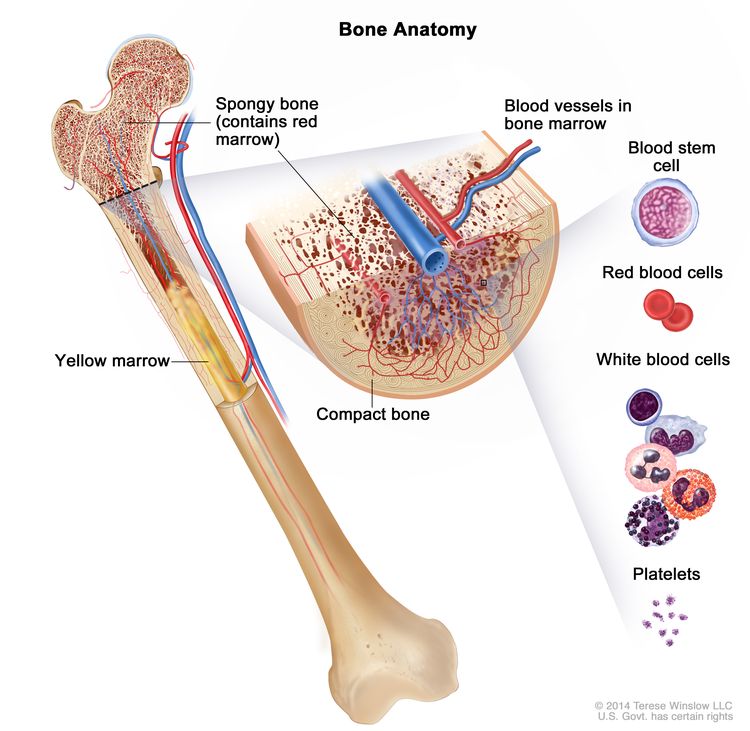 Anatomy of the bone. The bone is made up of compact bone, spongy bone, and bone marrow. Compact bone makes up the outer layer of the bone. Spongy bone is found mostly at the ends of bones and contains red marrow. Bone marrow is found in the center of most bones and has many blood vessels. There are two types of bone marrow: red and yellow. Red marrow contains blood stem cells that can become red blood cells, white blood cells, or platelets. Yellow marrow is made mostly of fat.
Anatomy of the bone. The bone is made up of compact bone, spongy bone, and bone marrow. Compact bone makes up the outer layer of the bone. Spongy bone is found mostly at the ends of bones and contains red marrow. Bone marrow is found in the center of most bones and has many blood vessels. There are two types of bone marrow: red and yellow. Red marrow contains blood stem cells that can become red blood cells, white blood cells, or platelets. Yellow marrow is made mostly of fat.
Normally, the bone marrow makes blood stem cells (immature cells) that become mature blood cells over time. A blood stem cell may become a myeloidstem cell or a lymphoid stem cell. A lymphoid stem cell becomes a white blood cell. A myeloid stem cell becomes one of three types of mature blood cells:
- Red blood cells that carry oxygen and other substances to all tissues of the body.
- Granulocytes, which are white blood cells that help fight infection and disease.
- Platelets that form blood clots to stop bleeding.
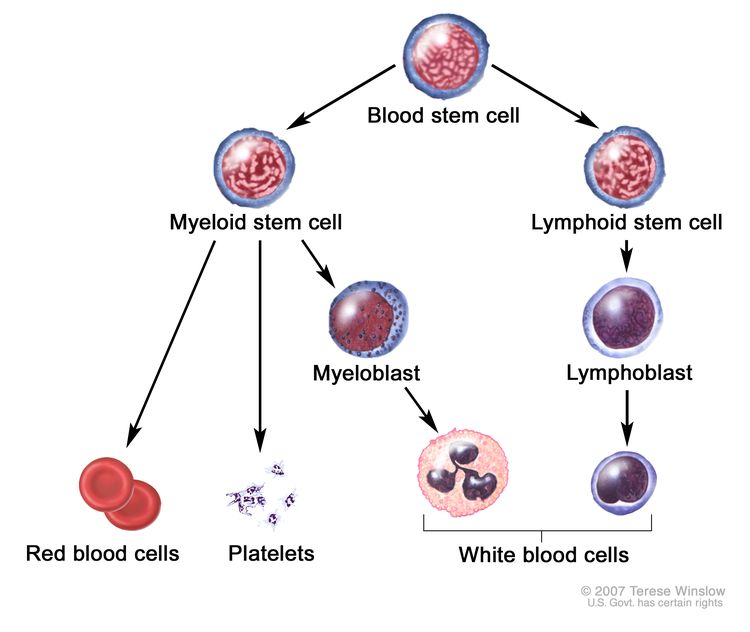 Blood cell development. A blood stem cell goes through several steps to become a red blood cell, platelet, or white blood cell.
Blood cell development. A blood stem cell goes through several steps to become a red blood cell, platelet, or white blood cell.
Myelodysplastic/myeloproliferative neoplasms have features of both myelodysplastic syndromes and myeloproliferative neoplasms.
In myelodysplastic diseases, the blood stem cells do not mature into healthy red blood cells, white blood cells, or platelets. The immature blood cells, called blasts, do not work the way they should and die in the bone marrow or soon after they enter the blood. As a result, there are fewer healthy red blood cells, white blood cells, and platelets.
In myeloproliferative diseases, a greater than normal number of blood stem cells become one or more types of blood cells and the total number of blood cells slowly increases.
This summary is about neoplasms that have features of both myelodysplastic and myeloproliferative diseases. See the following PDQ summaries for more information about related diseases:
- Myelodysplastic Syndromes Treatment
- Chronic Myeloproliferative Neoplasms Treatment
- Chronic Myelogenous Leukemia Treatment
There are different types of myelodysplastic/myeloproliferative neoplasms.
The 3 main types of myelodysplastic/myeloproliferative neoplasms include the following:
- Chronic myelomonocytic leukemia (CMML).
- Juvenile myelomonocytic leukemia (JMML).
- Atypical chronic myelogenous leukemia (CML).
When a myelodysplastic/myeloproliferative neoplasm does not match any of these types, it is called myelodysplastic/myeloproliferative neoplasm, unclassifiable (MDS/MPN-UC).
Myelodysplastic/myeloproliferative neoplasms may progress to acute leukemia.
Tests that examine the blood and bone marrow are used to diagnose myelodysplastic/myeloproliferative neoplasms.
The following tests and procedures may be used:
- Physical exam and health history: An exam of the body to check general signs of health, including checking for signs of disease such as an enlarged spleen and liver. A history of the patient’s health habits and past illnesses and treatments will also be taken.
- Complete blood count (CBC) with differential: A procedure in which a sample of blood is drawn and checked for the following:
- The number of red blood cells and platelets.
- The number and type of white blood cells.
- The amount of hemoglobin (the protein that carries oxygen) in the red blood cells.
- The portion of the sample made up of red blood cells.
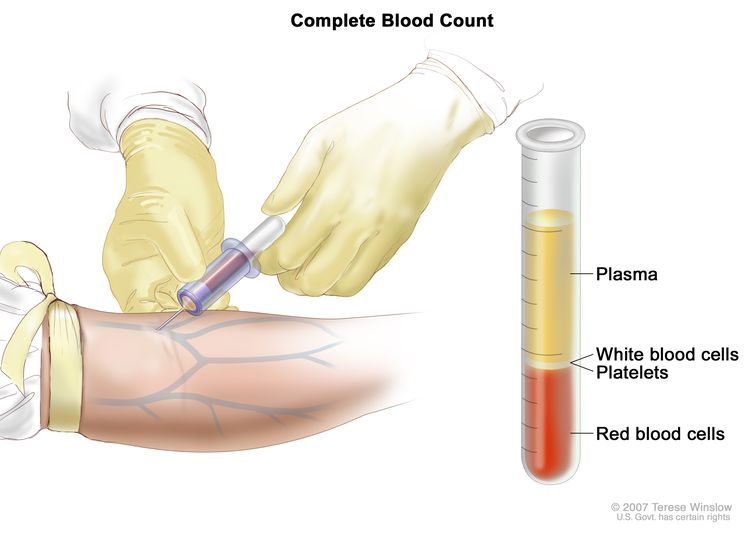 Complete blood count (CBC). Blood is collected by inserting a needle into a vein and allowing the blood to flow into a tube. The blood sample is sent to the laboratory and the red blood cells, white blood cells, and platelets are counted. The CBC is used to test for, diagnose, and monitor many different conditions.
Complete blood count (CBC). Blood is collected by inserting a needle into a vein and allowing the blood to flow into a tube. The blood sample is sent to the laboratory and the red blood cells, white blood cells, and platelets are counted. The CBC is used to test for, diagnose, and monitor many different conditions. - Peripheral blood smear: A procedure in which a sample of blood is checked for blast cells, the number and kinds of white blood cells, the number of platelets, and changes in the shape of blood cells.
- Blood chemistry studies: A procedure in which a blood sample is checked to measure the amounts of certain substances released into the blood by organs and tissues in the body. An unusual (higher or lower than normal) amount of a substance can be a sign of disease.
- Bone marrow aspiration and biopsy: The removal of a small piece of bone and bone marrow by inserting a needle into the hipbone or breastbone. A pathologist views both the bone and bone marrow samples under a microscope to look for abnormal cells.
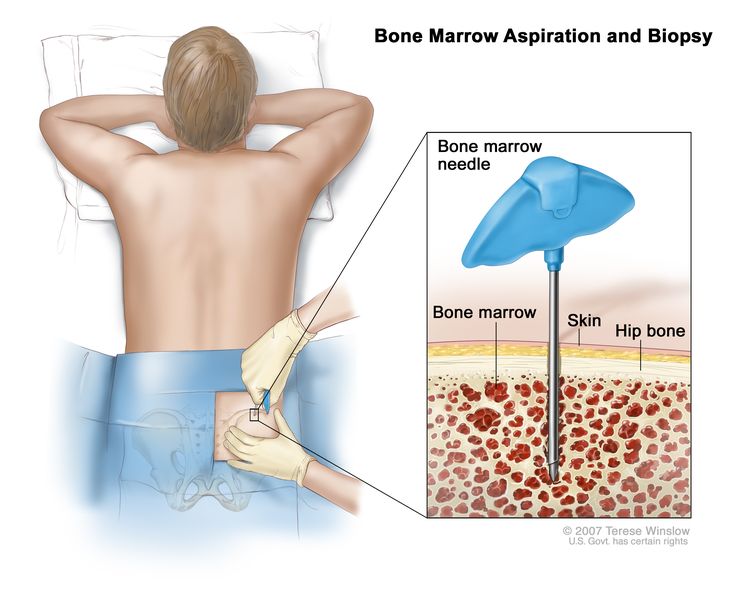 Bone marrow aspiration and biopsy. After a small area of skin is numbed, a bone marrow needle is inserted into the patient’s hip bone. Samples of blood, bone, and bone marrow are removed for examination under a microscope.
Bone marrow aspiration and biopsy. After a small area of skin is numbed, a bone marrow needle is inserted into the patient’s hip bone. Samples of blood, bone, and bone marrow are removed for examination under a microscope.The following tests may be done on the sample of tissue that is removed:
- Cytogenetic analysis: A laboratory test in which the chromosomes of cells in a sample of bone marrow or blood are counted and checked for any changes, such as broken, missing, rearranged, or extra chromosomes. Changes in certain chromosomes may be a sign of cancer. Cytogenetic analysis is used to help diagnose cancer, plan treatment, or find out how well treatment is working. The cancer cells in myelodysplastic/myeloproliferative neoplasms do not contain the Philadelphia chromosome that is present in chronic myelogenous leukemia.
- Immunocytochemistry: A laboratory test that uses antibodies to check for certain antigens (markers) in a sample of a patient’s bone marrow. The antibodies are usually linked to an enzyme or a fluorescent dye. After the antibodies bind to the antigen in the sample of the patient's bone marrow, the enzyme or dye is activated, and the antigen can then be seen under a microscope. This type of test is used to help diagnose cancer and to tell the difference between myelodysplastic/myeloproliferative neoplasms, leukemia, and other conditions.
Chronic Myelomonocytic Leukemia
Key Points for this Section
- Chronic myelomonocytic leukemia is a disease in which too many myelocytes and monocytes (immature white blood cells) are made in the bone marrow.
- Older age and being male increase the risk of chronic myelomonocytic leukemia.
- Signs and symptoms of chronic myelomonocytic leukemia include fever, weight loss, and feeling very tired.
- Certain factors affect prognosis (chance of recovery) and treatment options.
Chronic myelomonocytic leukemia is a disease in which too many myelocytes and monocytes (immature white blood cells) are made in the bone marrow.
In chronic myelomonocytic leukemia (CMML), the body tells too many blood stem cells to become two types of white blood cells called myelocytes and monocytes. Some of these blood stem cells never become mature white blood cells. These immature white blood cells are called blasts. Over time, the myelocytes, monocytes, and blasts crowd out the red blood cells and platelets in the bone marrow. When this happens, infection, anemia, or easy bleeding may occur.
Older age and being male increase the risk of chronic myelomonocytic leukemia.
Anything that increases your chance of getting a disease is called a risk factor. Possible risk factors for CMML include the following:
- Older age.
- Being male.
- Being exposed to certain substances at work or in the environment.
- Being exposed to radiation.
- Past treatment with certain anticancer drugs.
Signs and symptoms of chronic myelomonocytic leukemia include fever, weight loss, and feeling very tired.
These and other signs and symptoms may be caused by CMML or by other conditions. Check with your doctor if you have any of the following:
- Fever for no known reason.
- Infection.
- Feeling very tired.
- Weight loss for no known reason.
- Easy bruising or bleeding.
- Pain or a feeling of fullness below the ribs.
Certain factors affect prognosis (chance of recovery) and treatment options.
The prognosis and treatment options for CMML depend on the following:
- The number of white blood cells or platelets in the blood or bone marrow.
- Whether the patient is anemic.
- The amount of blasts in the blood or bone marrow.
- The amount of hemoglobin in red blood cells.
- Whether there are certain changes in the chromosomes.
Juvenile Myelomonocytic Leukemia
Key Points for this Section
- Juvenile myelomonocytic leukemia is a childhood disease in which too many myelocytes and monocytes (immature white blood cells) are made in the bone marrow.
- Signs and symptoms of juvenile myelomonocytic leukemia include fever, weight loss, and feeling very tired.
- Certain factors affect prognosis (chance of recovery) and treatment options.
Juvenile myelomonocytic leukemia is a childhood disease in which too many myelocytes and monocytes (immature white blood cells) are made in the bone marrow.
Juvenile myelomonocytic leukemia (JMML) is a rare childhood cancer that occurs more often in children younger than 2 years. Children who have neurofibromatosis type 1 and males have an increased risk of juvenile myelomonocytic leukemia.
In JMML, the body tells too many blood stem cells to become two types of white blood cells called myelocytes and monocytes. Some of these blood stem cells never become mature white blood cells. These immature white blood cells are called blasts. Over time, the myelocytes, monocytes, and blasts crowd out the red blood cells and platelets in the bone marrow. When this happens, infection, anemia, or easy bleeding may occur.
Signs and symptoms of juvenile myelomonocytic leukemia include fever, weight loss, and feeling very tired.
These and other signs and symptoms may be caused by JMML or by other conditions. Check with your doctor if you have any of the following:
- Fever for no known reason.
- Having infections, such as bronchitis or tonsillitis.
- Feeling very tired.
- Easy bruising or bleeding.
- Skin rash.
- Painless swelling of the lymph nodes in the neck, underarm, stomach, or groin.
- Pain or a feeling of fullness below the ribs.
Certain factors affect prognosis (chance of recovery) and treatment options.
The prognosis and treatment options for JMML depend on the following:
- The age of the child at diagnosis.
- The number of platelets in the blood.
- The amount of a certain type of hemoglobin in red blood cells.
Atypical Chronic Myelogenous Leukemia
Key Points for this Section
- Atypical chronic myelogenous leukemia is a disease in which too many granulocytes (immature white blood cells) are made in the bone marrow.
- Signs and symptoms of atypical chronic myelogenous leukemia include easy bruising or bleeding and feeling tired and weak.
- Certain factors affect prognosis (chance of recovery).
Atypical chronic myelogenous leukemia is a disease in which too many granulocytes (immature white blood cells) are made in the bone marrow.
In atypical chronic myelogenous leukemia (CML), the body tells too many blood stem cells to become a type of white blood cell called granulocytes. Some of these blood stem cells never become mature white blood cells. These immature white blood cells are called blasts. Over time, the granulocytes and blasts crowd out the red blood cells and platelets in the bone marrow.
The leukemiacells in atypical CML and CML look alike under a microscope. However, in atypical CML a certain chromosome change, called the "Philadelphia chromosome" is not there.
Signs and symptoms of atypical chronic myelogenous leukemia include easy bruising or bleeding and feeling tired and weak.
These and other signs and symptoms may be caused by atypical CML or by other conditions. Check with your doctor if you have any of the following:
- Shortness of breath.
- Pale skin.
- Feeling very tired and weak.
- Easy bruising or bleeding.
- Petechiae (flat, pinpoint spots under the skin caused by bleeding).
- Pain or a feeling of fullness below the ribs on the left side.
Certain factors affect prognosis (chance of recovery).
The prognosis for atypical CML depends on the number of red blood cells and platelets in the blood.
Myelodysplastic/ Myeloproliferative Neoplasm, Unclassifiable
Key Points for this Section
- Myelodysplastic/myeloproliferative neoplasm, unclassifiable, is a disease that has features of both myelodysplastic and myeloproliferative diseases but is not chronic myelomonocytic leukemia, juvenile myelomonocytic leukemia, or atypical chronic myelogenous leukemia.
- Signs and symptoms of myelodysplastic/myeloproliferative neoplasm, unclassifiable, include fever, weight loss, and feeling very tired.
Myelodysplastic/myeloproliferative neoplasm, unclassifiable, is a disease that has features of both myelodysplastic and myeloproliferative diseases but is not chronic myelomonocytic leukemia, juvenile myelomonocytic leukemia, or atypical chronic myelogenous leukemia.
In myelodysplastic/myeloproliferativeneoplasm, unclassifiable (MDS/MPD-UC), the body tells too many blood stem cells to become red blood cells, white blood cells, or platelets. Some of these blood stem cells never become mature bloodcells. These immature blood cells are called blasts. Over time, the abnormal blood cells and blasts in the bone marrow crowd out the healthy red blood cells, white blood cells, and platelets.
MDS/MPN-UC is a very rare disease. Because it is so rare, the factors that affect risk and prognosis are not known.
Signs and symptoms of myelodysplastic/myeloproliferative neoplasm, unclassifiable, include fever, weight loss, and feeling very tired.
These and other signs and symptoms may be caused by MDS/MPN-UC or by other conditions. Check with your doctor if you have any of the following:
- Fever or frequent infections.
- Shortness of breath.
- Feeling very tired and weak.
- Pale skin.
- Easy bruising or bleeding.
- Petechiae (flat, pinpoint spots under the skin caused by bleeding).
- Pain or a feeling of fullness below the ribs.
Stages of Myelodysplastic/ Myeloproliferative Neoplasms
Key Points for this Section
- There is no standard staging system for myelodysplastic/myeloproliferative neoplasms.
There is no standard staging system for myelodysplastic/myeloproliferative neoplasms.
The process used to find out if cancer has spread is called staging. There is no standard staging system for myelodysplastic/myeloproliferativeneoplasms. It is important to know the type of myelodysplastic/myeloproliferative neoplasm in order to plan treatment.
Treatment Option Overview
Key Points for this Section
- There are different types of treatment for patients with myelodysplastic/myeloproliferative neoplasms.
- Five types of standard treatment are used:
- Chemotherapy
- Other drug therapy
- Stem cell transplant
- Supportive care
- Targeted therapy
- New types of treatment are being tested in clinical trials.
- Treatment for myelodysplastic/myeloproliferative neoplasms may cause side effects.
- Patients may want to think about taking part in a clinical trial.
- Patients can enter clinical trials before, during, or after starting their cancer treatment.
- Follow-up tests may be needed.
There are different types of treatment for patients with myelodysplastic/myeloproliferative neoplasms.
Different types of treatments are available for patients with myelodysplastic/myeloproliferativeneoplasms. Some treatments are standard (the currently used treatment), and some are being tested in clinical trials. A treatment clinical trial is a research study meant to help improve current treatments or obtain information on new treatments for patients with cancer. When clinical trials show that a new treatment is better than the standard treatment, the new treatment may become the standard treatment. Patients may want to think about taking part in a clinical trial. Some clinical trials are open only to patients who have not started treatment.
Five types of standard treatment are used:
Chemotherapy
Chemotherapy is a cancer treatment that uses drugs to stop the growth of cancer cells, either by killing the cells or by stopping them from dividing. When chemotherapy is taken by mouth or injected into a vein or muscle, the drugs enter the bloodstream and can reach cancer cells throughout the body (systemic chemotherapy). Combination chemotherapy is treatment using more than one anticancer drug.
See Drugs Approved for Myeloproliferative Neoplasms for more information.
Other drug therapy
13-cis retinoic acid is a vitamin-like drug that slows the cancer's ability to make more cancer cells and changes the way these cells look and act.
Stem cell transplant
Chemotherapy is given to kill abnormal cells or cancer cells. Healthy cells, including blood-forming cells, are also destroyed by the cancer treatment. Stem cell transplant is a treatment to replace the blood-forming cells. Stem cells (immature blood cells) are removed from the blood or bone marrow of the patient or a donor and are frozen and stored. After the patient completes chemotherapy, the stored stem cells are thawed and given back to the patient through an infusion. These reinfused stem cells grow into (and restore) the body's blood cells.
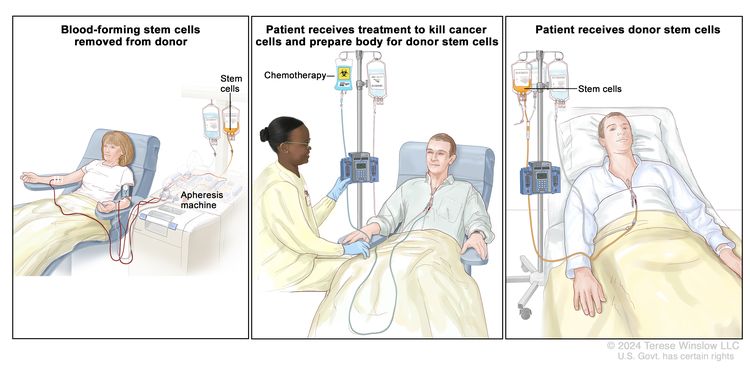 Donor stem cell transplant. (Step 1): Four to five days before donor stem cell collection, the donor receives a medicine to increase the number of stem cells circulating through their bloodstream (not shown). The blood-forming stem cells are then collected from the donor through a large vein in their arm. The blood flows through an apheresis machine that removes the stem cells. The rest of the blood is returned to the donor through a vein in their other arm. (Step 2): The patient receives chemotherapy to kill cancer cells and prepare their body for the donor stem cells. The patient may also receive radiation therapy (not shown). (Step 3): The patient receives an infusion of the donor stem cells.
Donor stem cell transplant. (Step 1): Four to five days before donor stem cell collection, the donor receives a medicine to increase the number of stem cells circulating through their bloodstream (not shown). The blood-forming stem cells are then collected from the donor through a large vein in their arm. The blood flows through an apheresis machine that removes the stem cells. The rest of the blood is returned to the donor through a vein in their other arm. (Step 2): The patient receives chemotherapy to kill cancer cells and prepare their body for the donor stem cells. The patient may also receive radiation therapy (not shown). (Step 3): The patient receives an infusion of the donor stem cells.
Supportive care
Supportive care is given to lessen the problems caused by the disease or its treatment. Supportive care may include transfusiontherapy or drug therapy, such as antibiotics to fight infection.
Targeted therapy
Targeted therapy is a type of treatment that uses drugs or other substances to identify and attack specific cancer cells. Targeted therapies usually cause less harm to normal cells than chemotherapy or radiation therapy do.
- Tyrosine kinase inhibitor (TKI) therapy: TKI therapy blocks signals that tumors need to grow. TKIs block the enzyme, tyrosine kinase, that causes stem cells to become more blood cells (blasts) than the body needs. Imatinib mesylate (Gleevec) is used to treat myelodysplastic/myeloproliferative neoplasm, unclassifiable. Other targeted therapy drugs are being studied in the treatment of juvenile myelomonocytic leukemia (JMML).
See Drugs Approved for Myeloproliferative Neoplasms for more information.
New types of treatment are being tested in clinical trials.
Information about clinical trials is available from the NCI website.
Treatment for myelodysplastic/myeloproliferative neoplasms may cause side effects.
For information about side effects caused by treatment for cancer, see our Side Effects page.
Patients may want to think about taking part in a clinical trial.
For some patients, taking part in a clinical trial may be the best treatment choice. Clinical trials are part of the cancer research process. Clinical trials are done to find out if new cancer treatments are safe and effective or better than the standard treatment.
Many of today's standard treatments for cancer are based on earlier clinical trials. Patients who take part in a clinical trial may receive the standard treatment or be among the first to receive a new treatment.
Patients who take part in clinical trials also help improve the way cancer will be treated in the future. Even when clinical trials do not lead to effective new treatments, they often answer important questions and help move research forward.
Patients can enter clinical trials before, during, or after starting their cancer treatment.
Some clinical trials only include patients who have not yet received treatment. Other trials test treatments for patients whose cancer has not gotten better. There are also clinical trials that test new ways to stop cancer from recurring (coming back) or reduce the side effects of cancer treatment.
Clinical trials are taking place in many parts of the country. Information about clinical trials supported by NCI can be found on NCI’s clinical trials search webpage. Clinical trials supported by other organizations can be found on the ClinicalTrials.gov website.
Follow-up tests may be needed.
Some of the tests that were done to diagnose the cancer or to find out the stage of the cancer may be repeated. Some tests will be repeated in order to see how well the treatment is working. Decisions about whether to continue, change, or stop treatment may be based on the results of these tests.
Some of the tests will continue to be done from time to time after treatment has ended. The results of these tests can show if your condition has changed or if the cancer has recurred (come back). These tests are sometimes called follow-up tests or check-ups.
chronic myelomonocytic leukemiaTreatment of Chronic Myelomonocytic Leukemia
For information about the treatments listed below, see the Treatment Option Overview section.
Treatment of chronic myelomonocytic leukemia (CMML) may include the following:
- Chemotherapy with one or more agents.
- Stem cell transplant.
- A clinical trial of a new treatment.
Use our clinical trial search to find NCI-supported cancer clinical trials that are accepting patients. You can search for trials based on the type of cancer, the age of the patient, and where the trials are being done. General information about clinical trials is also available.
juvenile myelomonocytic leukemiaTreatment of Juvenile Myelomonocytic Leukemia
For information about the treatments listed below, see the Treatment Option Overview section.
Treatment of juvenile myelomonocytic leukemia (JMML) may include the following:
- Combination chemotherapy.
- Stem cell transplant.
- 13-cis-retinoic acidtherapy.
- A clinical trial of a new treatment, such as targeted therapy.
Use our clinical trial search to find NCI-supported cancer clinical trials that are accepting patients. You can search for trials based on the type of cancer, the age of the patient, and where the trials are being done. General information about clinical trials is also available.
atypical chronic myeloid leukemia, BCR-ABL1 negativeTreatment of Aypical Chronic Myelogenous Leukemia
For information about the treatments listed below, see the Treatment Option Overview section.
Treatment of atypical chronic myelogenous leukemia (CML) may include the following:
Use our clinical trial search to find NCI-supported cancer clinical trials that are accepting patients. You can search for trials based on the type of cancer, the age of the patient, and where the trials are being done. General information about clinical trials is also available.
myelodysplastic/myeloproliferative neoplasm, unclassifiableTreatment of Myelodysplastic/ Myeloproliferative Neoplasm, Unclassifiable
For information about the treatments listed below, see the Treatment Option Overview section.
Because myelodysplastic/myeloproliferativeneoplasm, unclassifiable (MDS/MPN-UC) is a rare disease, little is known about its treatment. Treatment may include the following:
- Supportive care treatments to manage problems caused by the disease such as infection, bleeding, and anemia.
- Targeted therapy (imatinib mesylate).
Use our clinical trial search to find NCI-supported cancer clinical trials that are accepting patients. You can search for trials based on the type of cancer, the age of the patient, and where the trials are being done. General information about clinical trials is also available.
To Learn More About Myelodysplastic/ Myeloproliferative Neoplasms
For more information from the National Cancer Institute about myelodysplastic/myeloproliferativeneoplasms, see the following:
- Myeloproliferative Neoplasms Home Page
- Stem Cell Transplants in Cancer Treatment
- Drugs Approved for Myeloproliferative Neoplasms
- Targeted Therapy to Treat Cancer
For general cancer information and other resources from the National Cancer Institute, see the following:
- About Cancer
- Staging
- Chemotherapy and You: Support for People With Cancer
- Radiation Therapy and You: Support for People With Cancer
- Coping with Cancer
- Questions to Ask Your Doctor about Cancer
- For Survivors and Caregivers
About This PDQ Summary
About PDQ
Physician Data Query (PDQ) is the National Cancer Institute's (NCI's) comprehensive cancer information database. The PDQ database contains summaries of the latest published information on cancer prevention, detection, genetics, treatment, supportive care, and complementary and alternative medicine. Most summaries come in two versions. The health professional versions have detailed information written in technical language. The patient versions are written in easy-to-understand, nontechnical language. Both versions have cancer information that is accurate and up to date and most versions are also available in Spanish.
PDQ is a service of the NCI. The NCI is part of the National Institutes of Health (NIH). NIH is the federal government’s center of biomedical research. The PDQ summaries are based on an independent review of the medical literature. They are not policy statements of the NCI or the NIH.
Purpose of This Summary
This PDQ cancer information summary has current information about the treatment of myelodysplastic/ myeloproliferative neoplasms. It is meant to inform and help patients, families, and caregivers. It does not give formal guidelines or recommendations for making decisions about health care.
Reviewers and Updates
Editorial Boards write the PDQ cancer information summaries and keep them up to date. These Boards are made up of experts in cancer treatment and other specialties related to cancer. The summaries are reviewed regularly and changes are made when there is new information. The date on each summary ("Updated") is the date of the most recent change.
The information in this patient summary was taken from the health professional version, which is reviewed regularly and updated as needed, by the PDQ Adult Treatment Editorial Board.
Clinical Trial Information
A clinical trial is a study to answer a scientific question, such as whether one treatment is better than another. Trials are based on past studies and what has been learned in the laboratory. Each trial answers certain scientific questions in order to find new and better ways to help cancer patients. During treatment clinical trials, information is collected about the effects of a new treatment and how well it works. If a clinical trial shows that a new treatment is better than one currently being used, the new treatment may become "standard." Patients may want to think about taking part in a clinical trial. Some clinical trials are open only to patients who have not started treatment.
Clinical trials can be found online at NCI's website. For more information, call the Cancer Information Service (CIS), NCI's contact center, at 1-800-4-CANCER (1-800-422-6237).
Permission to Use This Summary
PDQ is a registered trademark. The content of PDQ documents can be used freely as text. It cannot be identified as an NCI PDQ cancer information summary unless the whole summary is shown and it is updated regularly. However, a user would be allowed to write a sentence such as “NCI’s PDQ cancer information summary about breast cancer prevention states the risks in the following way: [include excerpt from the summary].”
The best way to cite this PDQ summary is:
PDQ® Adult Treatment Editorial Board. PDQ Myelodysplastic/ Myeloproliferative Neoplasms Treatment. Bethesda, MD: National Cancer Institute. Updated
Images in this summary are used with permission of the author(s), artist, and/or publisher for use in the PDQ summaries only. If you want to use an image from a PDQ summary and you are not using the whole summary, you must get permission from the owner. It cannot be given by the National Cancer Institute. Information about using the images in this summary, along with many other images related to cancer can be found in Visuals Online. Visuals Online is a collection of more than 3,000 scientific images.
Disclaimer
The information in these summaries should not be used to make decisions about insurance reimbursement. More information on insurance coverage is available on Cancer.gov on the Managing Cancer Care page.
Contact Us
More information about contacting us or receiving help with the Cancer.gov website can be found on our Contact Us for Help page. Questions can also be submitted to Cancer.gov through the website’s E-mail Us.